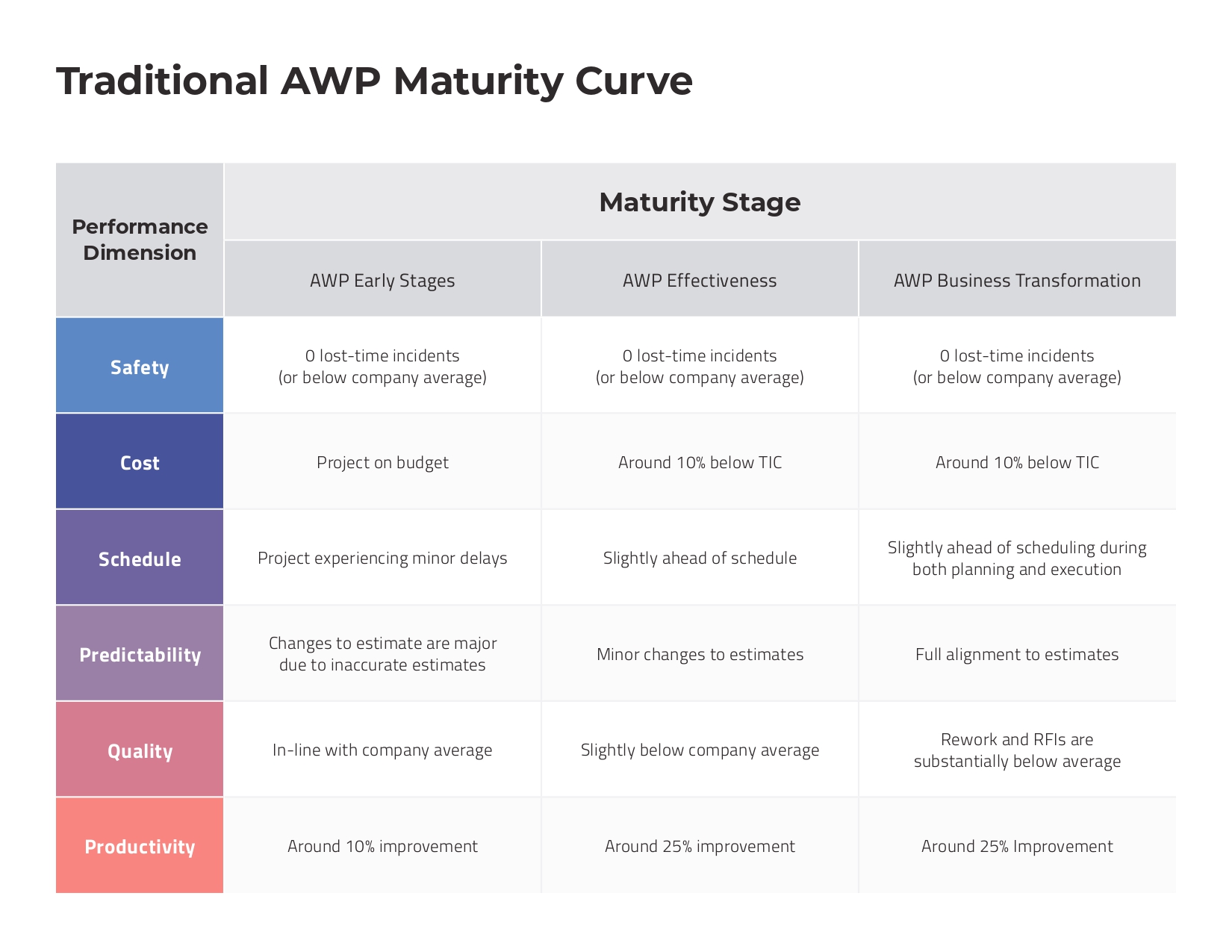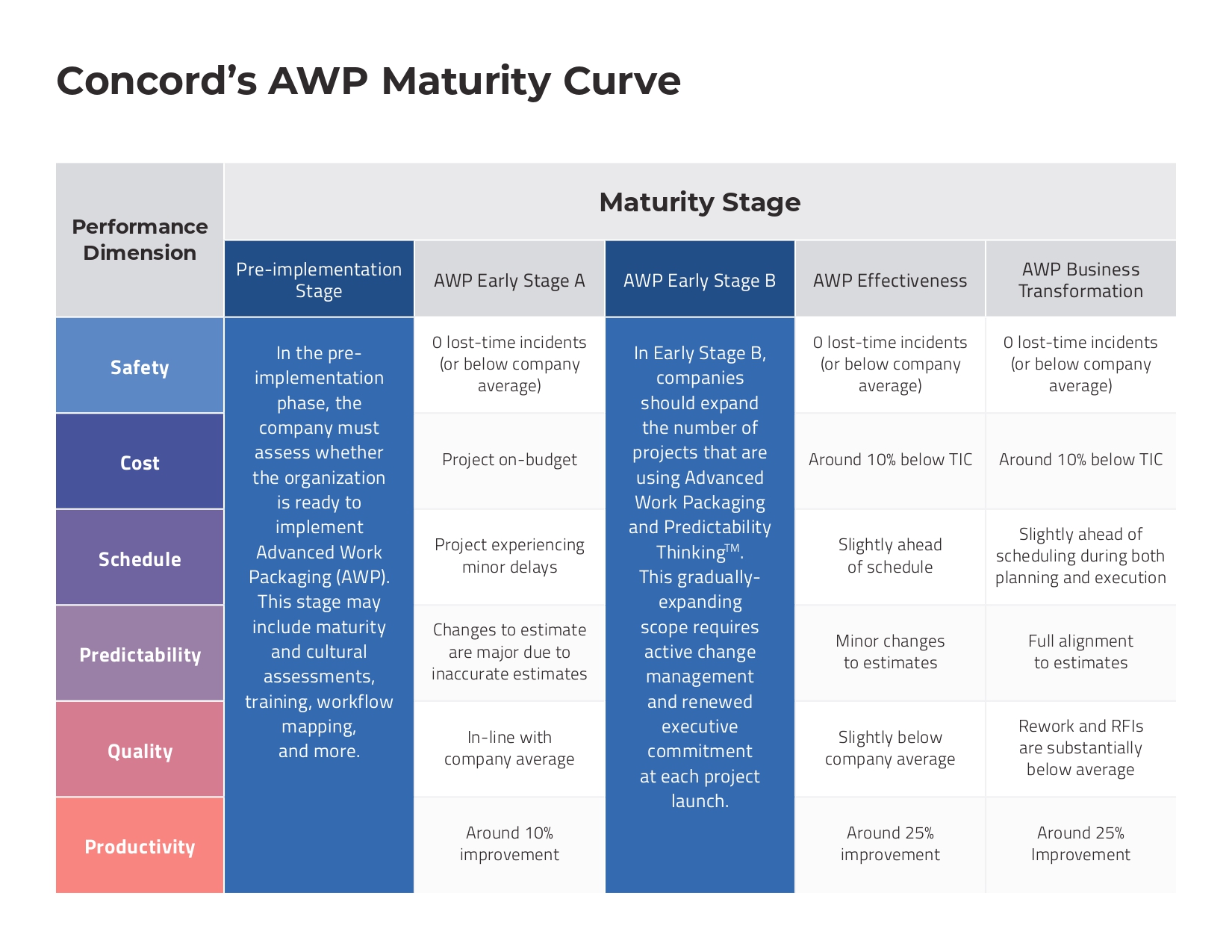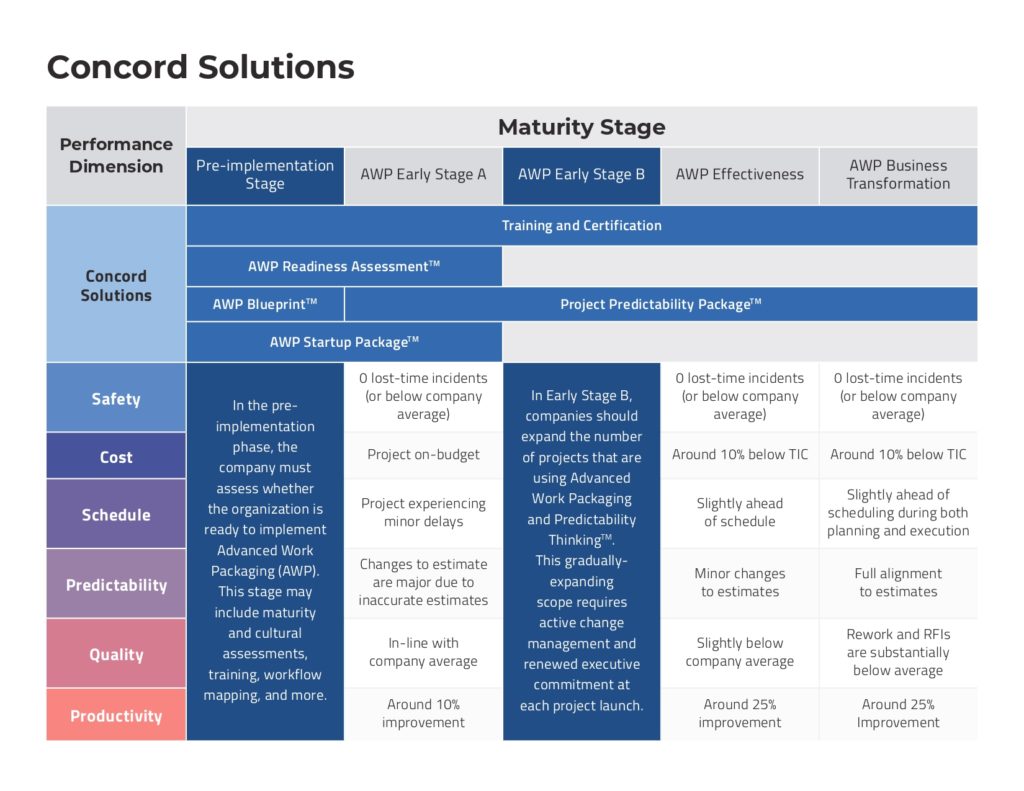It’s time to update our AWP maturity model to better reflect the messy reality of Advanced Work Packaging Implementation
The original Advanced Work Packaging maturity curve was developed by CII about a decade ago, and has been an important part of AWP implementation at many capital project organizations ever since. This succinct, three-step chart shows expected outcomes across six core areas as an organization moves through the implementation continuum. It is straightforward, linear, and promises exceptional improvements over time.
In our experience, few companies follow this maturity curve. It’s far more common for companies to initiate AWP implementation and quickly realize that their systems and culture are completely unprepared. Then they embark on remedial work — training, assessments, planning — and try again. The first project is filled with challenges, and once they’re up and running they need to slowly scale up from one project to two, then three, and so on, to make sure their people and systems work well and can withstand the pressures that come with company-wide implementation. For some large companies, complete Advanced Work Packaging implementation can take 10 years.
The original maturity curve doesn’t capture any of these deviations, and so we thought it might be time for an update. The new Concord®® Maturity Curve provides a more realistic overview of what companies can expect through the AWP implementation process. Take a look at the graphic below, and keep reading for a step-by-step guide to the new stages and what companies need to be working on in each one.
Side By Side: Compare Traditional vs. Concord® Maturity Curves
Slide the white bar to compare the two charts, then keep scrolling to read more about our implementations suggestions.


1 | Pre-Implementation Stage
What it is: During the new Pre-Implementation Stage, leaders assess whether the people and systems in their organization have the capacity to implement Advanced Work Packaging. If they do not — and most don’t — the company identifies and undertakes the work necessary to prepare the organization for AWP.
What to do: During the Pre-Implementation Stage you’ll conduct a Project Delivery System Maturity Assessment™ and develop an AWP Blueprint™. The maturity assessment evaluates your organization across seven dimensions and identifies strengths and weaknesses in terms of AWP preparedness; it will help you understand precisely what you need to do to get your organization ready for AWP. The blueprint will help you understand how AWP will fit with your existing improvement initiatives, so your teams are not working at cross-purposes with one another. This is also an excellent time to initiate an AWP Startup Package™.
2 | Early Stage A
What it is: The Early Stage A phase is your First Implementation, the organization’s initial attempt at using a construction-driven, AWP methodology on a project at your organization. Ideally, you’ll execute the project on-budget and with only minor delays, and you’ll reap some early benefits, including improved productivity.
What to do: The scope of work carried out by an organization in Early Stage A is far too broad to capture in a rundown like this one, but suffice it to say that the core work of Early Stage A can be boiled down to four points: set goals, allocate adequate funds, identify key roles and perform intensive training. An AWP StartUp Package™ can be helpful here.
3 | Early Stage B
What it is: The second new addition to the maturity curve, Early Stage B is an expansion stage during which companies who have completed a successful pilot project begin to integrate AWP into additional projects.
What to do: After your first project is complete, renew your executive support for AWP, ramp up your change management efforts and leverage what you’ve learned on your first project as you implement AWP on one or two more projects. Like a snowball rolling down a hill, as more and more projects move to the construction-driven delivery system, the more momentum you’ll enjoy. A Project Predictability Package™ is a good fit for organizations who need support.
4 | AWP Effectiveness
What it is: At this stage your organization will be reaping substantial rewards from your investment in AWP — you’ll have accurate estimates, limited rework, improved productivity and the project will be ahead of schedule and under-budget.
What to do: Set ambitious goals! Today, companies at this stage of the maturity curve still have a tremendous competitive advantage. Refine your practices and protocols and watch for complacency. An Enterprise Predictability Package™ can help.
5 | AWP Business Transformation
What it is: At this stage, AWP is simply “how you do business.” Your teams are fully aligned around construction-driven practices and protocols, and you’re reaping all the benefits of the practice including on-time, on-budget delivery, every time.
What to do: You’re in a league of your own, delivering world-class results and competing at the international level. Keep investing and refining your AWP processes. For most companies, this takes at least five years. Consider Predictability Thinking™ training to leverage cutting-edge strategies for improved project efficiency and effectiveness.
The new Concord®® Maturity Curve provides a more realistic overview of what companies can expect through the AWP implementation process.
Olfa Hamdi Tweet
What Does it Really Take to Succeed with AWP?
To close, I’d like to offer some general thoughts on what it takes to succeed with AWP in today’s market. First, and most important, you need formal executive support — I have never seen an AWP implementation succeed without it. You need to identify a leader to walk the organization through each stage of the maturity curve, and you need quantifiable results. Too many AWP implementation efforts wither due to lack of funding, so you’ll need an adequate budget. Finally, you need a communication plan for the next stage. And, of course, a contract with Concord®.
If you’re a capital projects leader looking to figure out where you fall on the maturity curve, Concord® can help. Click below to take the first step and book your PDS Maturity Assessment today!
Book Your Concord® PDS Maturity Assessment™ Today
Revitalize your Project Delivery System (PDS) in just six weeks with a Concord® PDS Maturity Assessment™ and Best Practice Selection Protocol.






